9 Plants That Flower in New Hampshire’s Cold Winters
BY JUDITH GALLOVA | JUNE 5TH, 2023 | LAWN CARE, NEW HAMPSHIRENew Hampshire is known for cold, snowy weather, but that doesn’t mean your yard has to be barren during the winter season. You can brighten it up with some beautiful winter plants that handle cold winters like a cool breeze. Check out these nine plants that flower in New Hampshire’s cold winters.
In this article:
New Hampshire Climate
While all of New Hampshire gets pretty chilly during the winter months, the climate varies depending on the region. Northern New Hampshire experiences colder temperatures and more snowfall than the southern part of the state.
That’s why it’s important to know your hardiness zone. Check it out here. We’ve mentioned the hardiness zone of each plant below so that you can pick the plants that will grow in your area.
9 Cold-Hardy Plants
1. Snowdrop (Galanthus Nivalis)
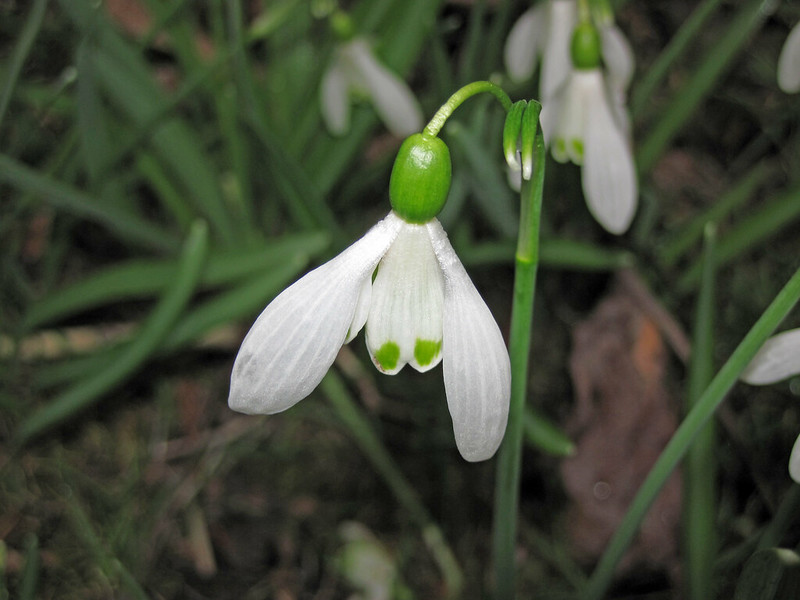
Photo Credit: James St. John / Flickr / CC BY 2.0
Snowdrop is a spectacular flower that blooms in thawing soil in late winter to early spring, producing delicate white blossoms that hang from its thin green stem. Not only does it bloom while snow is still on the ground, but it even lives up to its name with its snow-white petals that really look like droplets.
These little plants are often the first to appear in parks, but there’s nothing stopping you from planting them in your own yard. Plus, they’re easy to care for, too.
- Bloom time: Late winter to early spring
- Hardiness zones: 3 to 9
- Sun: Full sun, partial shade
- Water needs: Water in dry weather; water should have a slightly acidic pH; tap water may be too alkaline
- Soil: Clay, high in organic matter, loam, well-drained, occasionally wet soil, acidic to neutral
- Duration: Perennial
- Mature height: 4 to 10 inches
- Potential hazards: Toxic
2. Cornelian Cherry (Cornus Mas)
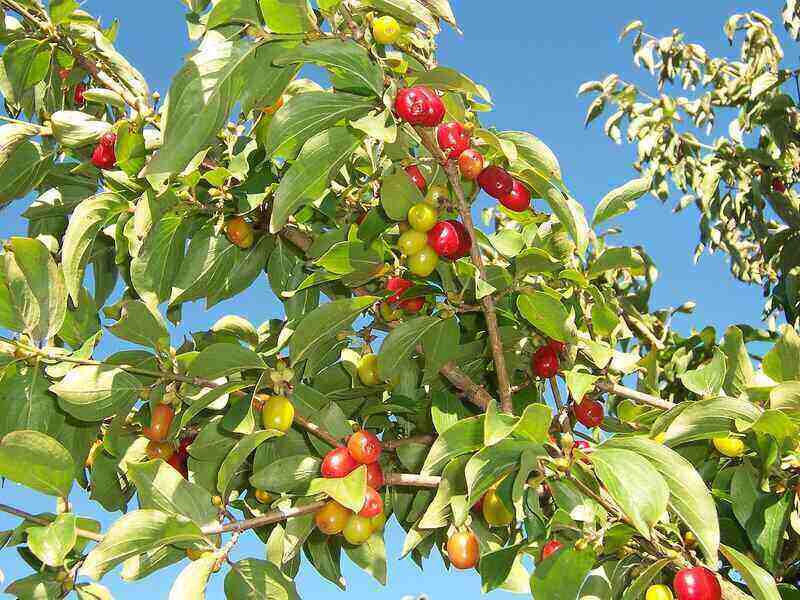
Photo Credit: I, B.navez / Wikimedia Commons / CC BY-SA 3.0
Blossoms in late winter, fruit in the summer – Cornelian cherry brings the whole package. Its fruit is quite sour, but it can be processed into jams, jellies, and syrups. If you want it to create a little privacy, that’s not a problem either; Cornelian cherry can grow up to 25 feet tall or be grown as a hedge. Fun fact: the shrub’s name is actually a misnomer. It’s not a cherry but a dogwood. Although it’s unsuitable for pets, you can certainly leave the fruit for local wildlife, like birds.
- Bloom time: Late winter to early spring
- Hardiness zones: 4 to 8
- Sun: Full sun, partial shade
- Water needs: Keep the soil moist at all times; while growing, the tree needs frequent watering, but mature trees can usually live off rainwater unless the weather gets too hot or when there’s no rainfall
- Soil: Slightly acidic to slightly alkaline, well-drained soil; preferably moist and organically rich, but tolerates clay-based
- Duration: Perennial
- Mature height: Up to 25 feet tall
- Potential hazards: Can cause issues if eaten by pets
3. Ornamental Kale and Cabbage (Brassica Oleracea)
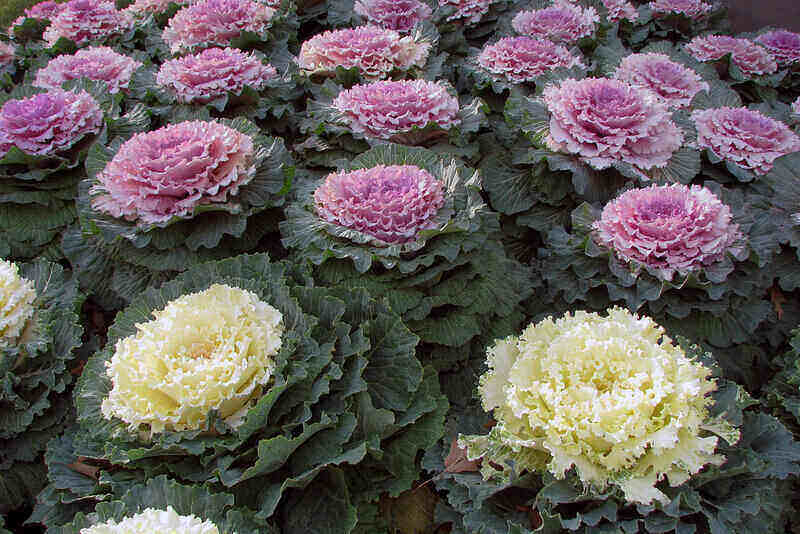
Photo Credit: Terren / Wikimedia Commons / CC BY 2.0
Ornamental kale and cabbage are like winter accessories for your yard. They add vibrancy during those snowy days. The rose blossom-shaped white and purple leaves of the plants make them popular with gardeners who want to add some color to their winter landscapes. They especially stand out in a group setting. Plus, ornamental kale and cabbage can look great as a garnish on your dinner plate.
- Bloom time: From fall to winter
- Hardiness zones: 2 to 11
- Sun: Full sun is ideal in New Hampshire, but some partial shade is OK, especially in warmer climates
- Water needs: An inch of water per week
- Soil: Consistently moist but not soggy, organically rich, loamy, well-drained soil; preferably slightly acidic
- Duration: Annual
- Mature height: 12 to 18 inches tall and wide
- Potential hazards: The plant has poisonous roots; the whole plant is also problematic for pets, so don’t let them eat it
4. Japanese Pieris (Pieris Japonica)
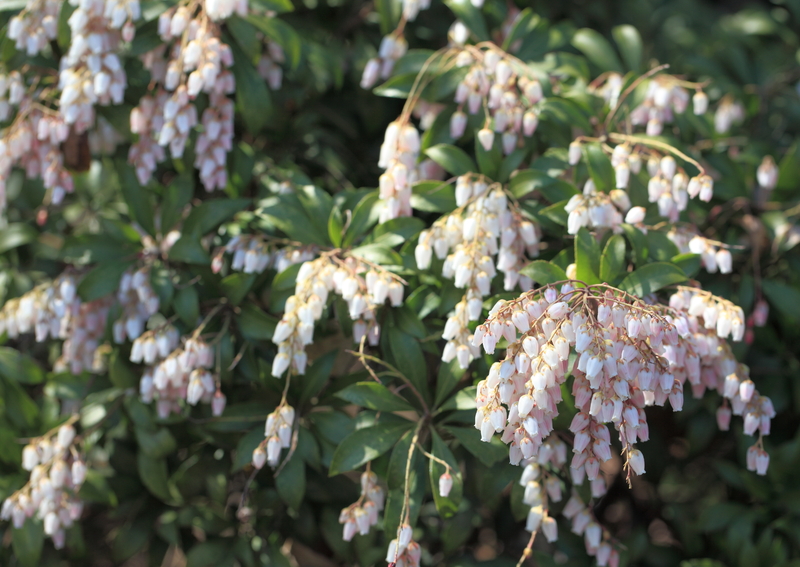
Photo Credit: PxHere
Also known as Japanese andromeda or lily-of-the-valley bush, Japanese pieris is a popular evergreen shrub that produces clusters of small, bell-shaped flowers in late winter to early spring. When it gets warm enough, the flowers attract bees. As one of its names suggests, its flowers resemble lilies of the valley, although their fragrance is not as strong. Also, take note that this shrub is more suitable for the southern part of New Hampshire.
Nevertheless, the Japanese pieris is a striking showpiece that can be used as a focal point in a garden or as a hedge. Shorter cultivars are also available for smaller spaces.
- Bloom time: Late winter to early spring
- Hardiness zones: 5 to 8
- Sun: Full sun, partial shade
- Water needs: Keep the soil moist at all times; water to about 3 inches deep once a week if there’s not enough rainfall
- Soil: Moist but well-drained, rich in organic matter, acidic soil
- Duration: Perennial
- Mature height: 9 to 12 feet tall
- Potential hazards: Severely toxic; be careful with your children and pets
5. Daffodil (Narcissus)
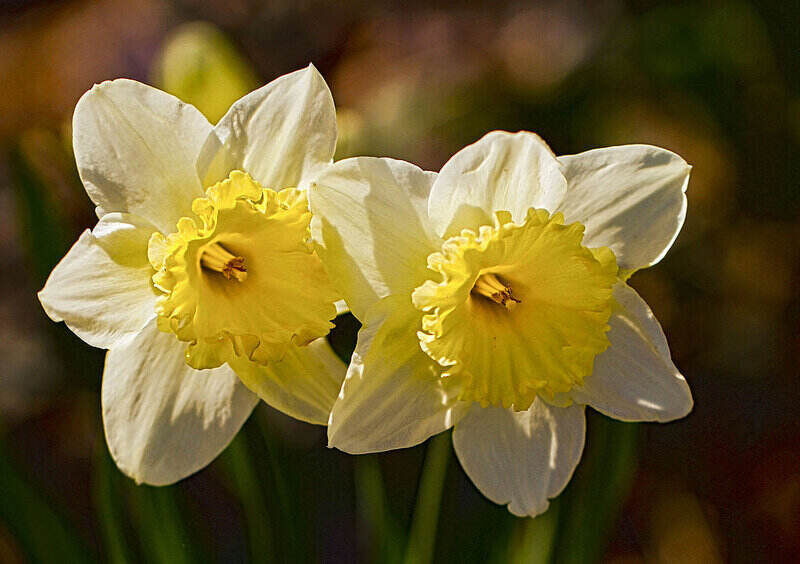
Photo Credit: Betty Wills / Wikimedia Commons / CC BY-SA 4.0
Daffodil is a spectacular and hardy bulb that’s super easy to care for and thrives in a variety of soil types, making it a great choice for beginners and advanced gardeners alike. And of course, planting these stunners in your yard is a great way to brighten it up with a pop of color.
- Bloom time: Late winter to early spring
- Hardiness zones: 4 to 8
- Sun: Ideally full sun, tolerates partial shade
- Water needs: 1 inch of water a week while they’re growing and blooming; water twice as much if your daffodils are planted near shrubs or under trees
- Soil: Fertile, rich, loose, loamy, and well-drained soil; ideally slightly acidic, but tolerates neutral; not too wet
- Duration: Perennial
- Mature height: Up to about 16 inches
- Potential hazards: Toxic
6. Winter Heath (Erica Carnea)
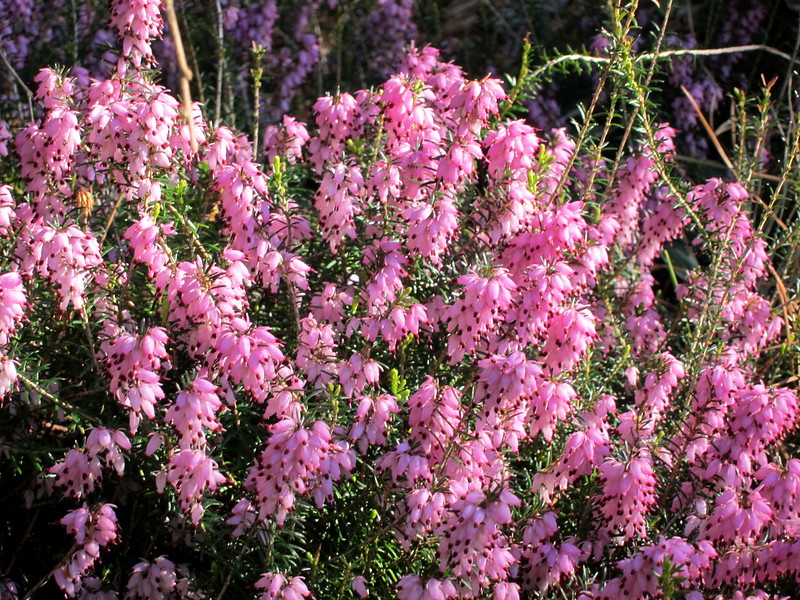
Photo Credit: K M / Flickr / CC BY 2.0
If you’re in the south of New Hampshire, you can try planting winter heath, a purple, pink, or white evergreen shrub that’s sure to brighten up your yard during the cold months. This early winter bloomer is easy to care for and thrives in the sun. It can also tolerate a little shade, but it may make its stems too long, affecting its appearance. Be sure not to fertilize this plant; it has a symbiotic relationship with soil fungi, so it gets enough nutrients unless it’s in a pot.
- Bloom time: Early winter to early spring
- Hardiness zones: 5 to 7 (some cultivars may live in zone 4)
- Sun: Full sun
- Water needs: Once or twice a week during the first season, when soil is dry; mature plants rarely need watering as they become resistant to dry conditions
- Soil: Ideally sandy, acidic, medium moisture, well-drained soil
- Duration: Perennial
- Mature height: Up to 9 inches tall
- Potential hazards: Some reports of toxicity; practice caution
7. Winter Aconite (Eranthis hyemalis)
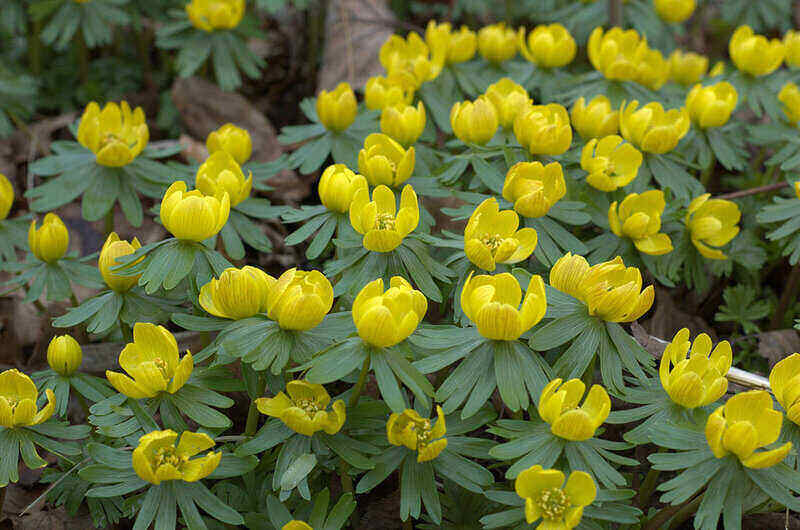
Photo Credit: Martin Olsson / Wikimedia Commons / CC BY-SA 3.0
The lovely winter aconite stands out for its yellow, buttercup-like flowers that provide a source of nectar for bees when they become active. The ground-hugging plant likes to peek through the blankets of snow, cheerfully signaling the end of winter and the arrival of spring. It’s likely to spread throughout your garden, so you’ll need to keep it in check.
- Bloom time: Late winter to early spring
- Hardiness zones: 3 to 7
- Sun: Full sun, partial shade
- Water needs: Needs year-round moisture, but while you may need to water more than twice a week in summer, watering is sparsely needed in winter
- Soil: Moist, moderately fertile, well-drained soil rich in organic material, with preferably slightly alkaline PH
- Duration: Tuberous perennial
- Mature height: 6 inches tall
- Potential hazards: One of the most toxic species; be careful
8. Winter Jasmine (Jasminum Nudiflorum)
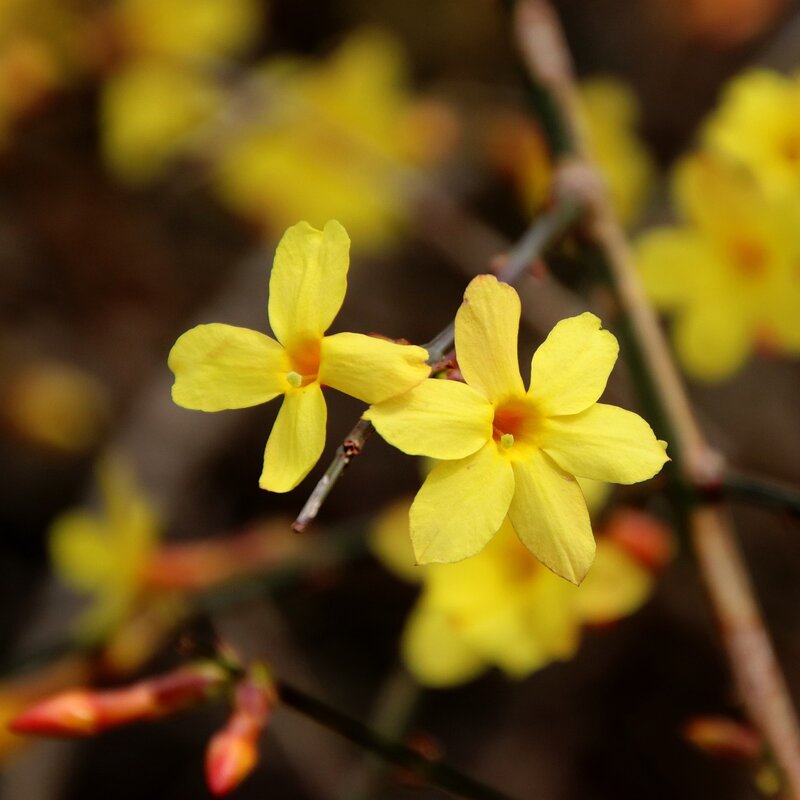
Photo Credit: Pixabay
If you’re in southern New Hampshire and want your yard to be covered in delicate yellow flowers throughout the winter, you can stop looking. Winter jasmine either grows as a groundcover or climbs up to 15 feet on a trellis. While it’s non-fragrant, it can cheer up your outdoor area with its green foliage and late-winter blooms.
This stunner of a plant is sometimes confused with the similar-looking forsythia, but unlike forsythia, winter jasmine blooms in the winter and isn’t known to be toxic.
- Bloom time: Late winter
- Hardiness zones: 6 to 9
- Sun: Full sun, partial shade
- Water needs: Higher than average, top of soil must not be dry; water once a week; more frequently during the summer when the weather gets hot
- Soil: Ideally fertile, loamy, soil rich in organic matter, but the plant isn’t picky and can do fine in poor soil; soil needs to be moist but not overwatered, well-drained with mildly pacific to neutral pH
- Duration: Perennial
- Mature height: Up to 4 feet tall, but can grow up to 15 feet tall on a trellis
- Potential hazards: None known, but caution is always advised; also, don’t confuse the plant for the toxic forsynthia
9. Sieber’s Crocus (Crocus Sieberi)
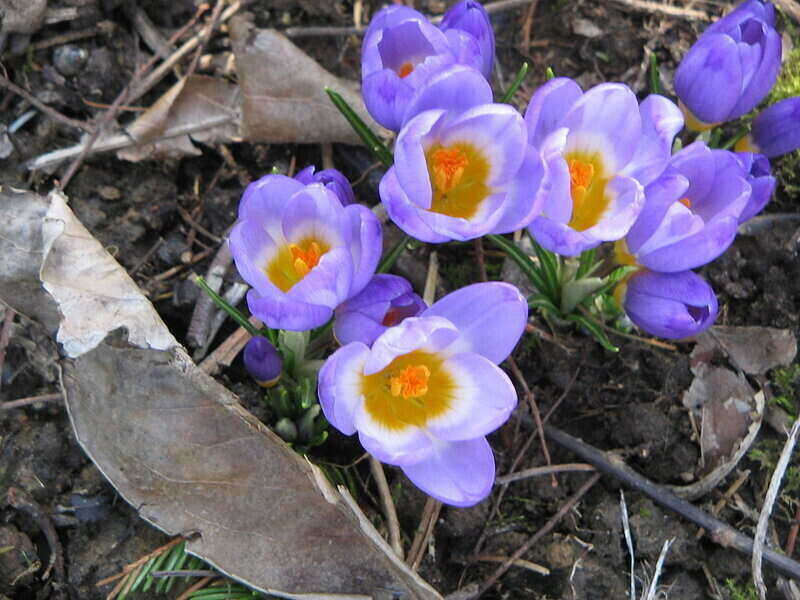
Photo Credit: Meneerke bloem / Wikimedia Commons / CC BY-SA 3.0
Sieber’s crocus will adorn your yard with beautiful, purple flowers in late winter to early spring. Sieber’s crocus is not just a real beauty, but it’s also resistant to cold and snow. Crocus species do well in New Hampshire in general, though, so feel f ree to check out other varieties and combine them to your liking.
- Bloom time: Late winter to early spring
- Hardiness zones: 3 to 8
- Sun: Full sun, partial shade
- Water needs: Water once a week; more frequently during the summer when the weather gets hot
- Soil: Average, medium moisture, slightly acidic to slightly alkaline, well-drained soil; thrives in sandy and gritty soils, doesn’t like heavy clay
- Duration: Perennial
- Mature height: 6 inches tall
- Potential hazards: Severely toxic; be careful
FAQ
Technically, they’re not blooming flowers, but ornamental cabbage and kale are known for their colorful foliage that lasts throughout the winter months.
Most winter plants don’t blossom until late winter. But if you plant winter heath, you can expect it to grow as early as December or January.
Many of the plants above are easy to grow. For example, you can try growing snowdrops, daffodils, winter heath, or ornamental kale and cabbage.
When to Hire a Landscaping Pro
Keeping your yard looking gorgeous all year is achievable, but it’s hard work that needs the right knowledge and tools. If you need some help, Wikilawn connects you to the best landscaping pros near you.
Main Photo By: Iris Wijngaarden / Wikimedia Commons / CC BY-SA 3.0